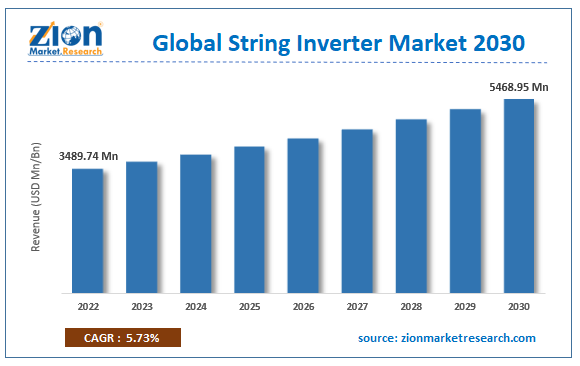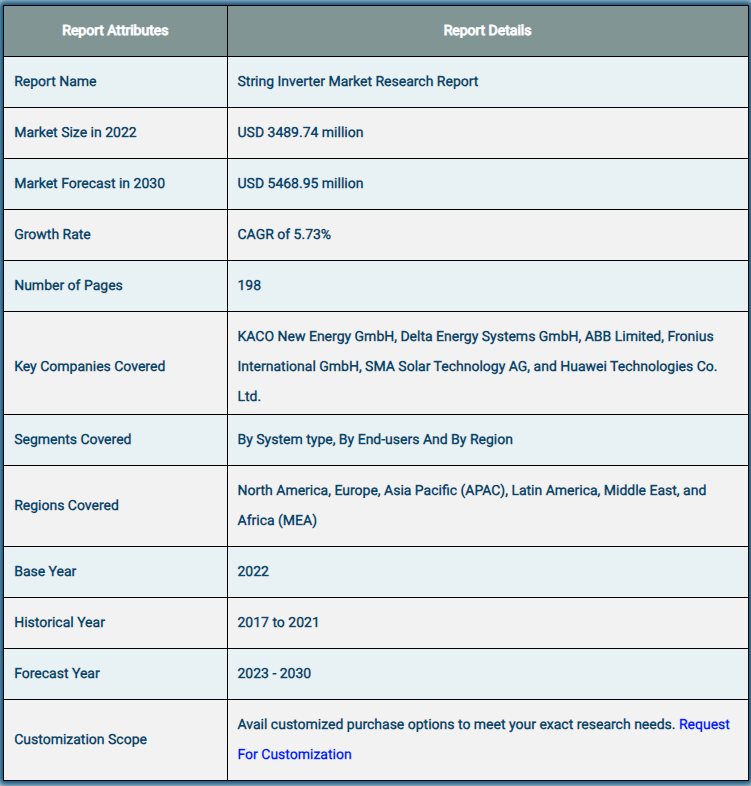The global string inverter market is expected to reach USD 5468.95 million by the end of 2032, from a projected value of USD 3489.74 million in 2024, according to a Zion Market Research analysis. Over the course of the projection period, the market is anticipated to rise at a CAGR of 5.73%. The growth factors, barriers, and effects on demand for the worldwide string inverter market are examined in this study for the period of forecasting. Additionally, it will support exploration and navigation of the emerging opportunities in the String Inverter market.
Abstract:
The string inverter market has become increasingly significant in the renewable energy sector, particularly in solar power systems. This research article delves into the current state of the string inverter market, exploring key trends, technological advancements, market dynamics, and future growth opportunities. It provides valuable insights for manufacturers, suppliers, investors, and policymakers interested in the renewable energy landscape.
Introduction:
String inverters play a crucial role in photovoltaic (PV) systems, converting direct current (DC) generated by solar panels into alternating current (AC) for use in residential, commercial, and industrial applications. This article examines the current market landscape, identifying key drivers, challenges, and opportunities that are shaping the future of the string inverter market.
 String Inverter Market
String Inverter Market
Market Overview for String Inverters
With a great majority of the global inverter market, string inverters are the option that is used the most commonly. However, despite string inverters’ dominance in the industry, MLPE technologies are rapidly gaining traction and market share because to their decreased cost. The solar panels are already set up in groups connected to “strings.” Each row of panels is connected to a single inverter, which converts the DC electricity generated by the panels into AC current that is compatible with the equipment. A string inverter system involves high-voltage electricity running across your top roof, which poses a risk of fire and arc faulting to both the installers and yourself.String inverters are not new; they have been available for many years. Because of this, the majority of string inverters are dependable, and electricians have a thorough understanding of the technology. In terms of cost, string inverters are currently more affordable than micro inverters. In contrast to micro inverters, which require one inverter for each panel, string inverters just need one for each installation.
 String Inverter Market
String Inverter Market
The market for string inverters: Growth Drivers
Reliability, proficiency, and ease of use are among the factors driving the worldwide string inverter industry. A few more features that might benefit the industry setting are light weight, small size, ease of installation, and capacity to increase power compactness. Lower component costs combined with extremely cheap ongoing protection will undoubtedly accelerate the growth of the string inverter business. Over the previous year, the three-phase inverter value has fallen due to advancements in expertise. Competitive pricing will increase its uptake among household and business users.
String Inverter Industry: Division
The market for string inverters is divided into two categories: off-grid and on-grid systems. The on-grid systems work well for small-to-medium-sized commercial and industrial solar applications with high efficacy. This is driving the three-phase string inverter industry, which has begun to see significant commercialisation in the Asia Pacific and Europe regions.
The market for string inverters is divided into two segments: utilities and commercial & industrial end users. In the upcoming years, it is projected that the utilities sector will dominate the string inverter industry. Large-scale utility projects are expanding the worldwide string inverter market for the utility sector and improving the current system for incorporating renewable energy.
String inverters are integrated with energy storage systems on islands and are expected to regulate regions where renewable energy penetration is highest. Due to the significant support from inverter manufacturers for the installation of three-phase string inverters in large power plants, it is projected that global shipments of inverters will quadruple in the next years.
Market for String Inverters: Report Extent
 String Inverter Market
String Inverter Market
Regional Analysis of the String Inverter Market
In the upcoming years, Asia Pacific is expected to have the largest market share for string inverters worldwide. According to government estimates, the global string inverter market will be driven in the upcoming years by incentives, regulatory assistance, feed-in traffics, tenders, and competitive bidding within the province.
Key Trends:
- Technological Advancements:
- Cost Reduction:
- Integration with Energy Storage:
- Grid Modernization:
Technological Innovations:
- High-Efficiency Inverters:
- Digitalization and IoT Integration:
- Advanced Safety Features:
Challenges and Barriers:
- Technical Challenges:
- Regulatory and Compliance Issues:
- Market Competition:
Future Opportunities:
- Emerging Markets:
- Technological Collaborations:
- Sustainability Initiatives:
Conclusion:
The string inverter market is poised for significant growth, driven by technological advancements, cost reductions, and increasing adoption of solar energy. While challenges related to technical reliability, regulatory compliance, and market competition persist, the market offers substantial opportunities for innovation and expansion. Stakeholders must stay informed about emerging trends and technological developments to leverage the full potential of the string inverter market.
Contact Us:
Zion Market Research212
USA/Canada Toll Free: 1 (855) 465–4651
Newark: 1 (302) 444–016611\s
Web: https://www.zionmarketresearch.com/
Blog: https://zmrblog.com/
